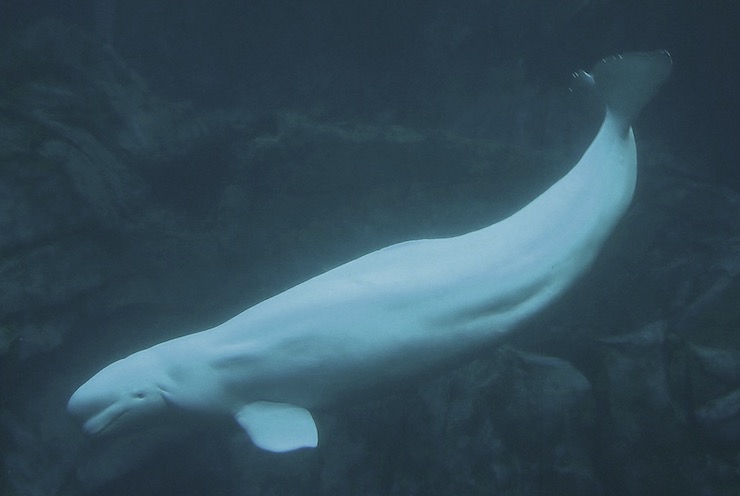
Photo by Greg Hume
For a short time, Beluga whales were considered near threatened on conservation lists. Through species protection, their populations improved and Belugas are no longer at risk of endangerment. Except for the population native to Cook Inlet along the Gulf of Alaska where Beluga populations are critically endangered with an annual decrease in 2.3%. Belugas are natives of arctic waters and are found near Russia, Greenland, and Alaska. Belugas are the only whales that are pure white, a trait that helps them blend into their arctic environment. Like their closest relatives the Narwhal, Belugas have no dorsal fins making it easier for them to swim under arctic ice sheets. Belugas are also social creatures who travel in pods and are known for their uniquely musical calls to other pod members earning them the nickname the Sea Canary.
Perfectly adapted to the icy waters of the north, Belugas rarely venture into warmer waters. They have been known to travel as far as Japan and Washington state. As they are opportunistic predators, they can find food wherever they go, but venturing to warm waters expose them to bacteria their bodies are not naturally prepared to fight off. So when Lisa LaPointe and Chris Faist from Gone Whale Watching in San Diego, CA spotted a large white animal in the southern California Pacific Ocean in the middle of the summer they were shocked. They quickly called their boss, Captain Domenic (Dom) Biagini to meet them with his drone to document this historic sighting, otherwise Lisa thought no one would ever believe them if they said they saw a Beluga whale off the coast of San Diego.
Dom is the owner of Gone Whale Watching, a US Coast Guard certified captain and a Part 107 licensed wildlife photographer. He explores the waters off San Diego year round, documenting with his DJI Phantom drone the wide range of marine life. Every single creature he spots with his drone is cataloged and shared for scientific research. He believes that with a drone, the wonders of the ocean can be experienced without trapping it inside of tanks. On his trips, Dom has documented Common dolphins, sometimes in pods with over 1,000 dolphins. Other regular sightings include Bottlenose, Pacific White-Sided, and Risso’s dolphins, as well as Blue, Killer, Grey, Humpback, Minke, Bryde’s, and Fin whales. He has even used his drone to capture rare (less than 5 times a year to only once every few years) sightings of Sperm, Pilot, Killer, and False Killer whales. But never had Dom seen a wild Beluga whale on his hundreds of adventures.
When Dom first got to the site where Lisa and Chris were waiting, it was hard for the crew to get close to the normally curious Beluga to identify it. Once Dom sent up his drone there was no question, they were looking at what he called “the unicorn we suspected it to be.” Though the Pacific Ocean is the world’s largest and deepest ocean, home to countless marine animals, it’s temperatures near San Diego in mid summer run between 65-70F. Where wild Belugas live in Alaska the summer water temperatures are around 50F. Yet, clear as day, Dom’s drone captured a lone Beluga whale gracefully swimming more than 6,000 miles from its natural home. As far as Dom knows, this marked the first time a Beluga whale had been spotted this far south.
Not only was it unusual to spot a Beluga whale near San Diego, but it was also odd that this whale was traveling alone. Though the drone footage shows a whale that experts agree looks healthy, they are baffled as to how it came to be alone in such a warm region. Suzanne Steinert, President of the Beluga Whale Alliance (BWA) based out of Girdwood, Alaska thinks that perhaps the whale followed a cold current as it made it’s way south. Others were worried that it was a Beluga whale that had escaped from either nearby Sea World of the Navy’s Marine Animal Program, both of whom confirmed it could not possibly be the situation.
A few days after Dom recorded the Beluga in San Diego, the whale was briefly spotted further north near Los Angles indicating that it was traveling home. That was the last it had been seen, but the BWA says they have a network set up along the coast to keep an eye out for it. Senior Research Scientist Ann Bowles of the Hubs Sea World Research Institute Bioacoustics Laboratory is particularly interested in learning more about this rouge Beluga whale. “We would love to know much more about who this whale is, where it came from, how it got down here, how it’s fairing, all that kind of stuff,” she said. This information could give researchers vital information on changing marine patterns. But as Dom said about the images he shared from his drone, “We aren’t really sure how this sighting was possible, but we hope this footage might help the experts come up with some theories!”
|